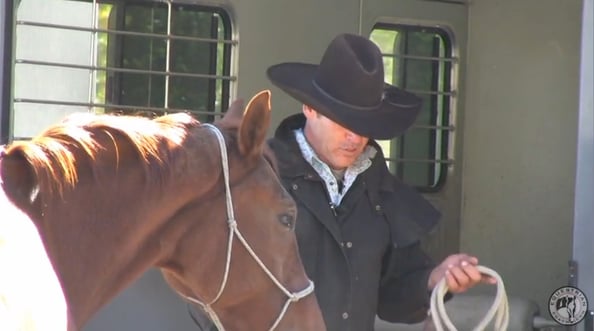Ah, the cold, bad-mannered horse.
You know the one. He’s used to pulling and jerking people around—and getting away with it. Try to load him on a trailer and he’ll stubbornly plant his feet, evading even the clearest cues with numbed indifference. Push him and he may resort to a head toss and/or body check aimed squarely in your direction.
While ill-mannered horses present a unique challenge for loading, all horses can be taught to be responsive, says master horseman Jose Alejos. If we use common sense.
“I don’t have a certain method for training a difficult horse to load,” he explains. “I try to go by feel and use my common sense. If you use your common sense in the world of horses, you will be successful most of the time.”

Here are ten tips from Alejos for successfully loading a poor-mannered horse.
1. Bigger trailers are betterGiven the option, bigger trailers are less intimidating than two-horse trailers for a horse that has never loaded before or is difficult to load.
“There’s more room for them to move in,” explains Alejos. “They don’t feel as claustrophobic.”
2. Play it cool“The first thing I do is put my energy low on my movements,” he continues.
Typically, a horse that is reluctant to load will stop at the ramp or several feet away from the trailer. When that occurs, Alejos keeps even pressure on the lead rope and walks into the trailer himself.
“I’m not nervous. I’m not tight on my movements. He can see me in the trailer, my energy is trapped in the trailer, and I’m still cool. I’m still the same,” he explains.
3. Focus on movement firstTo encourage the horse forward, Alejos gradually increases the pressure on the lead rope—clucking at the horse for encouragement.
“The trick here is that once you apply pressure, you don’t release it until the horse moves,” he says. “He can go up. He can go sideways. We let go of the pressure because we want him to move—even if it’s not necessarily towards me, the way I wanted.”
4. Work slowly and methodicallyFor every positive response, every step toward the trailer, pat the horse and let him take in his surroundings before asking him to load further into it.
“Let him smell the trailer. Let him think,” says Alejos.
“Every time he walks toward you, release. That’s the best gift a horse can have.”
5. Work where the horse is spooky.“If the horse gets spooky closer to the ramp, we work there,” he continues. “We don’t want to make him to jump into the trailer. We want to him to think about it. [To decide] everything is alright.”
6. Make resistance uncomfortableIf the horse is rude—he invades your personal space or aggressively pulls you out of the trailer—move him away from you quickly with energetic pressure on the lead line.
“Make that moment a little uncomfortable,” says Alejos. “He needs to know that that move was a little mistake he made.”
Then bring you energy back to a calm place and re-approach the trailer, again applying patient and persistent pressure.
7. Pay attention to inherent risks“If we pull hard when he’s part way in the trailer and he rears up, he’s going to hit his head on the roof and we don’t want that. That will really scare him,” cautions Alejos.
8. Training doesn’t stop once horse loads“Once the horse is in the trailer, most people just shut the gate, then get everything ready—we’re going! We want him to back up out of the trailer and feel free again,” says Alejos.
Notice if the horse is licking and chewing once he’s out of the trailer, a sign of understanding. Then try reloading him again a few times.
9. Remember, you’re on horse time.It may take more than one training session to teach a horse to load calmly and confidently. “If you can’t load him, fine. Try again tomorrow,” he says.
“Horses don’t care about time. They don’t care if it’s early in the morning or if it’s in the evening. So we have to think the same. There’s no hurry.”
10. Be patientTraining a horse to load on a trailer takes patience—a lot of patience, advises Alejos. “Just be cool with the horse. Don’t lose your temper. If you lose your temper, you lost.”
For video footage of this exercise, see “Trailer Loading Difficult Horses with Jose Alejos” on EquestrianCoach.com.


